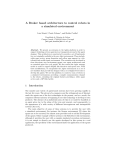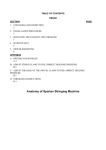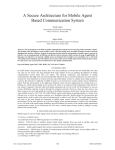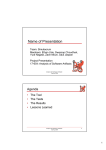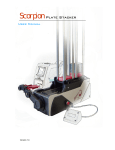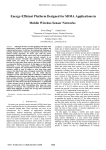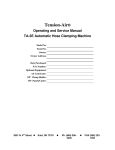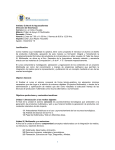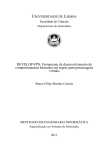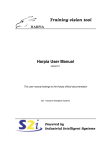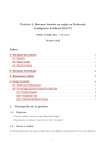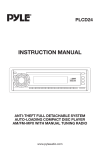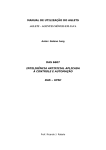Download An educational environment to construct behaviour based robots
Transcript
AGLIPS: An educational environment to
construct behaviour based robots
Luis Moniz1 , Paulo Urbano1 , and Helder Coelho1
Faculdade de Ciências de Lisboa
Campo Grande, 1749-016 Lisboa, Portugal
{hal,pub,hcoelho}@di.fc.ul.pt
Abstract. We present a tool to aid the construction and management
of behaviour-based robot in a simulated environment that shows collective behaviour. This framework is based on two different tools: the
extended Aglets multiagent platform plus the Player/Stage environment
for robotics simulation. The framework AGLIPS links these two heterogeneous environments into a single platform, providing us with a tool for
constructing agents and an environment for experimenting them. The
resulting testbed merges the Aglets platform features and the dynamic
and unpredictable characteristics of the Player/Stage environment producing a joint tool capable of combining social and physical aspects of
agents useful for more advanced experiments.
1
Introduction
Verifiable scientific experiments require that they can be repeated independently
of time and space. The designer needs tools to construct, manipulate, and measure the experiment. Most of physical experiments with behaviour-based agents
are very time and cost consuming, and most of the time is spent in hardware
calibration and trouble shooting. Only a small amount of the resources is used in
the design of real robot mind. Another problem arises from the nature of a real
experiment, and it resides on the proper analysis of the outcomes. Due to the
distributed nature of the robots and to the fact that no central control exists, it
is very difficult to get data and identify what were the processes that originated
certain behaviour. Motivated by these problems, we developed a tool to build
behaviour-based agents that evolve in a simulated environment. This framework
incorporates characteristics of intelligent agents environments (Aglets)[5] and
multiagent simulation tools (Player/Stage)[2, 8, 4]. The possibility of repeating
an experiment, by changing some initial parameters, allows the user to conduct
simulations and observe how different conditions influence different behaviours.
Similar work has been developed in control of simulated robots, the Teambots[3], the Robocode[7] and the Robosoccer[6] frameworks provide tools to develop and test teams of robots. These frameworks provide a simulation platform
where the robots can be executed, but they provide almost no control over the
simulation itself. For instance the Robocode framework only allows to add and
remove robots, but once the simulation is started the user can only observe the
robots’ behaviour and interactions. The Robosoccer simulator allows the simulations of a soccer game and build experiments with coordination in a complex
environment, also once the simulation starts the user lose the control over the
individual robots although it still gets a minimal control over the simulation as
referee.
Our tool objective is to overcome these limitations, giving the user control
over each individual robot engaged in the simulation and over the simulation
environment, and provide a mechanism to make simulation analysis. We allow
the user to send commands to the robot individually, changing its predefined
behaviour during the simulation, or issue commands to a specific group of robots.
Another advantage is the capability, through special agents, to extract data from
the robots and environment, and use it to make posteriori analysis of each robot
performance.
The remainder of the paper is organised as follows. Section 2 will address the
individual features of both platforms and how they interact. Section 3 presents
the Virtual Laboratory architecture and what is available to build robots. Section
4 shows an experimental example of chasing behaviour.
2
Aglips Framework
Our platform framework is constructed based on two different tools: the Aglets
environment and the Player/Stage platform. The Aglets environment is an cognitive and mobile agent oriented environment with a set of tools to construct
agents and a platform where the agents can be executed and controlled. The
Player/Stage platform is a simulated environment to build and simulate behaviourbased robots whose code can be downloaded into real machines.
2.1
The Aglets Environment
The Aglets environment is a platform inside which all the agents, mandatory
written in JAVA, are executed. This platform provides the agents with a set
of services (message transport, mobility, cloning, etc) and an execution model
that must be followed. The Aglet life cycle is event driven, and it based in the
Aglet response to these events. An Aglet must be constructed regarding the
model that regulates its life cycle, we must define what to do when it is created,
when it moves or when it is removed from the platform. In the platform, each
agent is identified by an aglet proxy (a kind of internal address), associated
with it at creation time. The platform supports a message transport service
based on aglets proxies. The knowledge of these proxies is crucial to all the
agents in order to support the communication among them. The environment
does not provide a central mechanism to track the agents and know who is
active when. For instance, when an agent moves from one platform to another
its proxy changes, making that all the other agents loose its contact. The system
provides also a control interface and aglet viewer (Tahiti) with which the user
can launch aglets, control their state, and remove them from the platform. The
Aglet architecture structure is based on its life cycle. For instance, when an Aglet
is created inside the platform, its creation method is invoked, and then when it
is activated the run method is invoked. The same happens to all main events
on the Aglet cycle, to each one there is an Aglet behaviour pre-determined to
be invoked. The definition of an aglet behaviour is made by redefining some of
these methods, identifying which actions should be performed in each situation.
This architecture and the use of the JAVA language to define agents have some
advantage when redefining Aglets based on previous ones; it is only needed to
define what is different. For instance, if we have an Aglet that checks whenever
email arrives, we can use this agent to define other that remove all spam mail,
based on some criteria.
2.2
The Player/Stage Environment
The Player/Stage platform simulates a team of mobile robots moving and sensing in a two-dimensional environment. The robots behaviours are controlled
through the Player component of the system. The Stage component provides
a set of virtual devices to the Player, various sensors models, like a camera, a
sonar and a laser, and actuators models, like motors and a griper. It also controls
the physical laws of robot interaction with each other and the obstacles. In our
current environment only the sonar, laser and motors are usable. This tool provides a controllable framework to build tests and experiments in a simple robotic
environment. The physical environment is defined in set of files containing the
number and position of each robot, the host/port from which each robot can be
controlled and the obstacles disposition (in a graphics file).
2.3
Interface Environment
The interface environment provides the user with a set of tools to access and
control the Aglets and Player/Stage environments. This environment has three
different tools: the agents’ manager, the agents’ consoles, and stage monitor.
The stage monitor provides us with a graphical representation of the environment and the robots during the simulations. It gives little control over the robot
simulation. The agents manager is an interface to allow the low level control of
the Aglets platform, for instance, it gives tools to launch/kill/move an agent,
start a simulation, monitor what agents are active, etc. In the figure 1 we present
an example of this interface.
In order to connect all these different environments we had to support heterogeneous communication tools. The communication Aglets and robots are supported by sockets and a Java API interface. This channel supports all sensors and
actuators. The basic mechanism of communication between agents is through
message passing. This service is supported by special agents inside the Aglets
platform that provide the environment with white pages service and message
routing. The direct communication among robots is not supported.
Fig. 1. The Aglips Interface. This picture presents a view of the Aglips environment:
agent manager, stage viewer, agent/robot consoles and agent controller
3
The Virtual Laboratory
Along with the complexity of the environment, the design of the agent is decisive for the collection of its behaviours. The agent’s behaviour is determined
by its control program, as well as the available actuators and sensors and their
positioning on the agent’s body. The virtual laboratory allows users to build experiments in a modular way. Agents are composed of a control mind agent in the
Aglets platform, a body equipped with sensors and actuators in the Player/Stage
environment, and the user interface device (see Fig.2). The user can build up
a library of different agents, control programs and environments, which can be
combined for different experiments. The environment can be tailored to the experiment: the user defines the number, size, and disposition of obstacles, number
and position of robots, and the behaviour of each robot.
In the next sections, we will overview the framework and present what tools
are available to construct the desired experiments.
3.1
Agents, Robots and Clips
The integration of the Player/Stage environment with the Aglet platform allowed
us to add some new features to the environment and to associate an aglet to
manage each robot. This aglet controls the robot behaviour using the Player
interface (sensing and actuating), and it is capable of communicate with the
other aglets (robots) through the platform. This extension provides the robots
with a communicating channel (peer to peer and broadcast) that provides them
with complex message exchange capabilities. Additionally we add a GPS to the
system, providing the robot with the knowledge of its absolute position in the
environment. We also associate a simple console command line and display to
each aglet. Through this console it is possible to track the aglet execution and
communicate directly with it. We also add the possibility of add a special aglet
without a robot attached. This aglet revealed itself useful to track the aglet
simulation and to communicate with the other agents, for instance, to broadcast
a message to all of them.
Fig. 2. The Aglips architecture. This figure shows an example of an Aglips supported
experiment. Note that not all aglets had an associated robot or console, they can
support other tasks, such as, experiment controllers, aglets managers or performance
meters
The Fig. 3 shows how the robot architecture is organised in layers. The
bottom layer corresponds to the features provided by the Aglet platform. This
corresponds to the sequence of actions executed during the Aglet life cycle and
some system tools, like send messages, mobility commands, etc. The next layer
(Aglet Extended architecture) adds new functionalities to the base architecture.
These overlap some original functionalities and encapsulate other in order to
hide some repetitive tasks. For instance, when the agent is activated the first
action it must perform is to registrate itself with the broker, indicating who it
is and what are its main characteristics (kind, group, ...).
The Robot Base Architecture layer extends the Aglets with a CLIPS virtual
machine to help the definition of behaviours instead of the original Java virtual
machine. To simplify the design of the robot behaviour we choose to describe
it using CLIPS. The CLIPS language is a rule-based language with a forward
chaining based reasoning engine. The user can define the robot behaviour in
terms of first order logic rules, in the form of pairs conditions/actions. To support
the feature we had to incorporate Jess CLIPS interpreter engine in our Aglets
the as the CLIPS virtual machine. When an agent is created the file, where is
behaviour is defined, is passed as a parameter and loaded into the agent Jess
interpreter. Then the agent moves on standby mode. The agent is activated only
when it receives the run command. We also defined a set of robot modules to
support some Java functionalities in the CLIPS interpreter and to link the robot
with the stage environment. This level gives supports the construction of the
robot controllers. These are special purpose agents to issue simulation control
commands to the other robots, these commands are also given in CLIPS. For
instance, the user can (through a robot controller) command a simulation robot
to go to a specific location, run 10 rules of its behaviour or add a new rule to
the agent.
Fig. 3. The Aglips internal architecture is organized in layers, each built based on the
precedent and extended using modules
The Robot Clips Architecture layer allows us to tune our robots to specific
experiments without need to access to the system or modify the core architecture.
This layer is completely defined in CLIPS and it is specific to each robot. This
layer will be detailed in section 4.
Beside these layers, we also define a set of three modules to be used as
interface between layers. These modules are sets of functions and routines that
translate some of the layer internal features and gives external access to them.
For instance, we defined two classes of routines in the robots modules: functions
to interface with Stage/Player environment, and functions to accede to the Aglets
environment capabilities. These functions are mainly written in Java and then
they are exported as foreign code into the Jess environment.
In the next sections, we will detail some of the features added and how they
can be used to track our experiments.
3.2
Controller Agents
This class of agents is used to control the other agents during the simulation.
They can issue or broadcast commands to the other agents, provoking a predefined reply from them. The reply is defined in various levels relatively to the place
where the answer is embedded in the architecture. This corresponds to three levels in the architecture: Aglets extended architecture; Robots base architecture;
Robots CLIPS architecture (see Fig. 3).
In the first two levels the agent is compelled to fulfil the request due to
its own architectural constrains. These commands are embedded in the robot
architecture and they are not subject to be ignored. For instance, the ”suspend”
command forces the robot to a stop, no more rules are executed and its speed is
put to zero until the resume command is issued. The answer to the last group
of commands depends on the robot architecture. These commands are issued to
the robot, and it then chooses what to do.
Individual Controller Agents Each robot is associated with a controller
agent, which has its own private console. Each of the consoles has full control
over the respective robot. Through the console we can issue commands to the
robot, like suspend and resume its activity, and even kill the robot agent. We can
also obtain information concerning the robot perception and state and change
its parameters and behaviour. This console provide the user with information
concerning the associated robot internal states, allowing the correct tunning of
its behaviour.
Global Controller Agent This special built-in agent represents the observer
and is used to control the other agents in the simulation. The observer can
suspend and resume all robot agents. The controller can also interrupt on-line
every other robot agent order to send it commands: we may want to inspect its
state or to force it to begin a particular behaviour.We consider two agent classes
which must be controlled: (1) the robot agents and (2) the special agents. So,
the observer can broadcast commands to all agents, to all robot agents, to a
particular agent, and to a list of agents.
Table 1. Commands issued by the observer to globally control each of the individual
robots
height Directive Agent
(all-do
(robots-do
(you-do
(list-do
Command
command-name
command-name
agent-name command-name
agent-list
command-name
Parameters
arg1
arg1
arg1
arg1
. . . argn)
. . . argn)
. . . argn)
. . . argn)
These commands are not restricted to this agent, other agents can also use
them. But, for the global controller, which is the agent that set-up and run an
experiment, they are essential commands. We must remark that when an agent
broadcasts a message or a command it will never receive the message neither the
command.
This agent can be used mainly for control purposes, it had no access to the
internal state of any other agents, unless they explicitly provide that information.
3.3
Monitor Agents
We can use the Aglets facilities to produce intrusive monitor agents, capable of
generating real-time information about the environment and the robots. Instead
of exhibiting a transparent behaviour in the simulation, these agents request
the data directly from the robots and produce some analysis. In order to allow
this behaviour, the robots must understand the Monitor requests and answer
accordingly to them. Next we present a fragment of a Monitor behaviour.
Example of a Monitor agent behaviour
...
(robots-do activate)
(robots-do safe-wader)
(wait ?time)
(robots-do send-data ?myself)
(wait ?timeout)
(calc-statistics)
...
;activate all robots
;start wandering behaviour
;wait some time
;ask for behaviour data
;wait a timeout
;calculate with received data
We want to extend this class of agents incorporating more complex, detached
and transparent agents, capable of producing real time statistics, like how many
times each robot got stalled, which is the more efficient, the explored world, etc,
without interfere in the simulation. We should also note that these agents are
fully customized by the user, and it is possible to build Monitor agents with
specific characteristics, specially tunned to observe some given experiment.
Fig. 4. Tracking robots. This figure shows an example of construction of a graphic
representation of the robots path when performing the wander behavior in the cave
environment
3.4
Statistics
Built into the robot architecture is the log generation feature. These mechanisms
automatically generate an entry in a log file each time a rule is activated. Each
log is composed by a set of measures like time, robot position, robot speed and
robot state. This information can later be subject of a statistical analysis in
order to study the robot behaviour and performance.
We can see an example of statistical treatment of information produced by
the simulation in the Fig.4. This example shows the tracks of each robot during
the execution of the wandering behaviour during 5 minutes.
We can also use this log to make performance tests of the robots behaviour
and the workbench performance. For instance, it is possible to get how many
times a robot gets stucked in the environment or what is the difference between
two consecutive log entries. The Fig.5 shows an example of this workbench performance measure. We can observe regular peaks and a long-term degradation of
performance. The long-term degradation corresponds do the reducing of the time
between peaks, meaning that the robot is taking more time between successive
activation of rules.
Fig. 5. Performance measure. Time difference between successive log entries
Obtaining this performance measure is fundamental to our robot/workbench
tuning; the reason of this degradation could be a robot fault (someone starts
eating computer cycles on executing a rule) or a workbench problem that is
jamming the system. Identifying the correct motive can direct us to correct
design flaws of the entire system
4
Designing and Running Experiments
Let us imagine we want to build behaviour based robots that exhibit a flocking
behaviour in an world with obstacles. To achieve this, they have to keep all
moving together and, at the same time, avoid obstacles.
We have several alternatives to develop this behavior: we can use a low level
approach and describe all the robot behaviour in pure CLIPS; or, we can built
small pieces of CLIPS code that can be assembled together to built a higher level
description. We choose the second option to solve the problem. In the table 2 we
present some of these CLIPS blocks that we be used to produce the behaviour.
Table 2. Some macro commands available in the CLIPS module to buid robotic behaviours
Some commands in CLIPS module
(robots-inside-cone ?x ?y ?r ?angle)
(robot-inside-cone ?x ?y ?r ?angle)
(towards ?x ?y ?hx ?hy)
(robots-inside-circle ?x ?y ?r)
(Compass)
(compass-of robot)
(closest-robot ?x ?y)
(velocity)
(distance ?x ?y ?hx ?hy)
(robot-list)
(one-robot)
(Xcor)
(robot-inside-circle ?x ?y ?r) (Ycor)
(xcor-of robot)
(ycor-of robot)
(velocity-of robot)
Our robot behaviour can then be described in the following form: If there is
an obstacle the robot must turn away from it (velocity given by obstacles avoidance function) and if there is some other robot in the perception field then turn
towards the direction that robot is facing, otherwise maintain velocity (flocking vector function). Both these functions produce a pair (translation velocity,
rotation velocity) that should be applied to the robots motors to produce the desired behaviour. It is the obstacle avoidance behaviour that prevents the robots
to bump in each other, due the sonar sensor do not differentiate standing obstacles from robots. Next, we present a fragment of the CLIPS code that produce
this behaviour.
Example of a flocking behaviour with obstacle avoidance
...
if (< (min (sonar)) 750) then
Vvector = obstacle-avoidance-vector(sonar) else
Vvector = flocking-vector((robot-inside-cone) (xcor) (ycor)
(perception-range)
(angle-range))
(setSpeed Vvector)
...
We should note that this behaviour description is similar to a subsumption architecture with two levels, where the obstacle avoidance level can inhibit the flocking behaviour. Some of these experiments can be observed at
http://ai.di.fc.ul.pt/projects.
5
Conclusions
In this paper we present a tool to aid the construction and management of
behaviour-based robot in a simulated environment. We have focused mainly on
the overall architecture of our system and we have presented, in a shallow form,
a number of aspects that deserved to be treated in more depth. These include
a complete description of the workbench and its internal details of functioning,
the methodology to build behavior based robots and all the available modules
built in our system.
We introduced a number of features in our architecture which we believe to
be particularly important in future development of simulations. This include the
combination of the CLIPS rule based language to describe behaviours and the
capability of examine the agent mind during the simulation. This feature allows
us to have a complete and accurate image of the agent mind and understand
the shown behaviour. Another important feature is the inclusion in the system
of special agents to control and observe the simulation. Instead of the tradicional approach of pre-determined behaviours, these agents can be completely
constructed by the user and tunned for the experiment specific needs.
In the current stage of development the educational characteristics of the
system are not fully developed. We do believe that this framework can become an
acceptable tool to introduce agent programming basic concepts in a controllable
environment. The capability of statistics data generation by the agents can be an
important tool to analyse the overall performance of the agents and the society
evolution.
References
1. Ronald C. Arkin. Behavior-based Robotics. The MIT Press, 1998.
2. R. T. Vaugham B. Gerkey, K. Stoy. Player Robot Server, version 0.8c user manual
edition, 2001.
3. Tucker Balch.
TeamBots 2.0, web reference = http://www.cs.cmu.edu/
trb/teambots edition.
4. Kasper Sty Andrew Howard Gaurav S. Sukhatme Brian P. Gerkey, Richard
T. Vaughan and Maja J Mataric. Most valuable player: A robot device server
for distributed control. In Proceedings of the IEEE/RSJ International Conference
on Intelligent Robots and Systems (IROS 2001), 2001.
5. Mitsuru Oshima Danny B. Lange. Programming and Deploying Mobile Agents with
Java Aglets. Peachpit Press, 1998.
6. Mao Cheny et all. RoboCup Soccer Server, version 7.07 user manual edition, 2002.
7. Sing Li. Rock ’em, sock ’em Robocode: Round 2, web reference = http://www106.ibm.com/developerworks/library/j-robocode2/ edition.
8. Richard T. Vaugham. Stage: A Multiple Robot Simulator, version 0.8c user manual
edition, 2000.











